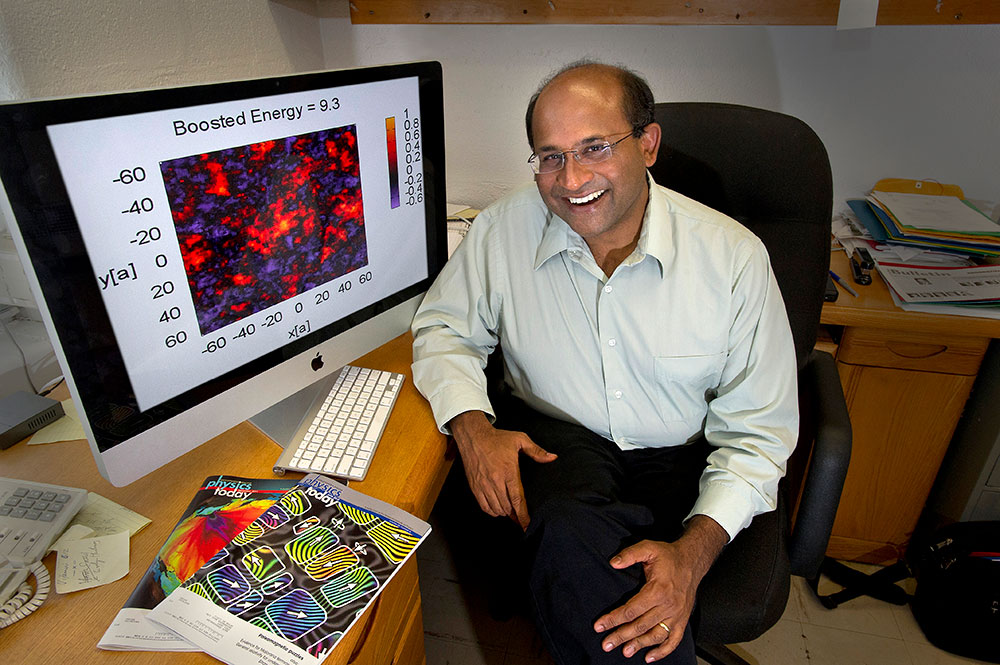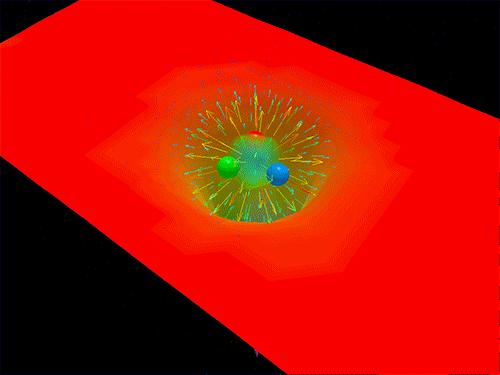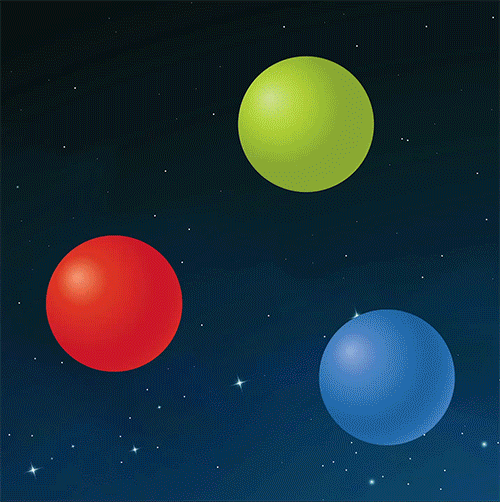Simons Foundation Announces New Collaboration on Confinement and QCD Strings
The collaboration brings together leading scientists and Brookhaven Lab nuclear physics facilities to explore how the building blocks of matter get their properties
July 28, 2022
 enlarge
enlarge
Raju Venugopalan, Senior Scientist in the Nuclear Theory Division of the Physics Department at Brookhaven National Laboratory.
The Simons Foundation has announced a new research collaboration to explore the “glue” that holds the visible matter of the universe together. This team of thirteen principal investigators, led by Igor Klebanov of Princeton University, will delve into the details of quantum chromodynamics (QCD)—the theory that describes the interactions among the most fundamental building blocks of visible matter.
“The collaboration will bring together three communities of theorists specializing in the study of experimental data, computation, and analytical approaches to QCD,” said Raju Venugopalan, a senior physicist at the U.S. Department of Energy’s (DOE) Brookhaven National Laboratory and adjunct professor at Stony Brook University, who is one of the principal investigators. “The big motivation is to bring together these communities to address a problem that’s at the heart of all matter”—namely, how the strong nuclear force keeps fundamental particles called quarks and gluons confined within the protons and neutrons that make up atomic nuclei.
“By understanding confinement, we can learn fundamentally how hadrons—protons, neutrons, and other composite particles made of quarks and gluons—are put together,” Venugopalan said.
Leveraging the Experiments
The theorists will benefit from close proximity to the researchers at—and the data generated by—the Relativistic Heavy Ion Collider (RHIC), a DOE Office of Science user facility for nuclear physics research located at Brookhaven Lab. Research at RHIC is all about quarks and gluons.
Experiments at RHIC smash together ions (the nuclei of atoms) travelling at nearly the speed of light. RHIC’s high energy heavy ion collisions recreate conditions last seen in the early universe, essentially dissolving the boundaries of individual protons and neutrons so that quarks and gluons are no longer confined within those individual nuclear building blocks. By tracking the variety of particles that stream out of the “quark-gluon plasma” (QGP) created in these collisions, RHIC’s detectors gather data on how quarks and gluons behave.
Nuclear theorists like Venugopalan also study QGP created in higher-energy heavy ion collisions at Europe’s Large Hadron Collider (LHC). They use the equations of QCD to both predict and interpret what the RHIC and LHC experiments might reveal. Known as “phenomenologists,” for their study of experimental phenomena, they form one arm of the new collaboration.
 enlarge
enlarge
Theorists like Venugopalan can use models of QCD to compute, at short distances, the behavior of dense gluon clouds in a RHIC/EIC collision. They now wish to understand how these dense clouds transform into chromoelectric flux tubes (QCD strings) at larger distances.
In the coming decade, they’ll also make use of data from the Electron-Ion Collider (EIC), a facility that will be built on the backbone of RHIC. The EIC will collide electrons with ions, essentially using the electron beams to “see” inside protons, neutrons, and nuclei.
“The Electron-Ion Collider will be the brightest, highest intensity ‘femtoscope’ to shine on the structure of matter,” Venugopalan said, referring to its ability to capture details on scales much smaller than a femtometer—that’s one millionth of a billionth of a meter! Using the future EIC, scientists will take “snapshots” of quarks and gluons and study their interactions within the matter that makes up our world today.
Lattice Computing
With as much as these experiments have (and will) reveal, understanding and predicting the interactions of quarks and gluons is complicated.
“The equations for QCD are extremely difficult to solve,” said Venugopalan. “In general, you cannot solve them using a pen and paper.”
Supercomputers can help, but physicists must be wary of how they input and run the equations describing QCD.
“If you put the theory into a computer naively, you would miss out on a lot of the details,” Venugopalan said.
 enlarge
enlarge
This animation is a visualization of the result of lattice simulations using the Yang-Mills equations of QCD, demonstrating the formation of chromoelectric flux tubes (QCD strings) at wide separations, confining quarks and gluons inside a proton (Credit: Derek Leinweber, CSSM, University of Adelaide).
In the quantum world, quarks and gluons can explore an infinite number of paths between two points in space and time—each with differing likelihoods, he explained. This makes the QCD equations hard to simulate.
To tackle this challenge, physicists invented a method called lattice QCD. As the name suggests, the method places each quark on a point on a four-dimensional “space-time” lattice, with gluons residing on the links between these points. A computer then models all the possible pathways quarks and gluons can take as they interact using the equations defined by QCD.
These calculations require the world’s most powerful supercomputers. Using increasingly large lattices with smaller and smaller spacing between points, the simulations can capture increasingly fine details.
“Lattice QCD simulations are now able to demonstrate, with high precision, that fundamental quarks and gluons generate the masses and other key properties of protons, neutrons, and sub-atomic particles governed by the strong force,” Venugopalan said.
Computational theorists who continue to develop and use lattice QCD are important members of the QCD-confinement collaboration. They will “design clever computational experiments that are focused on exploring confinement,” Venugopalan explained. For example, they’ll simulate QCD-like theories with different types of particles, different numbers of space-time dimensions, or at extreme temperatures. Such tools will give physicists the ability to stretch the principles of QCD beyond reality to advance their understanding of quark-gluon interactions.
“In a way theorists are playing games—almost like video games—because such simulations are not the real world,” Venugopalan said. “But these kinds of games can give us deeper insight into how confinement actually works.”
Bringing Back the Strings
Scientists know that, at its core, confinement is a result of the strong nuclear force. As its name implies, the strong force—which is generated by the interactions of quarks and gluons—is the strongest of the four fundamental forces of nature (the other three being electromagnetism, the weak force, and gravity). And it has a unique characteristic: Unlike the other three, the strong force doesn’t get weaker with increasing distance!
“We think of the quarks and gluons as being connected by a type of tube,” said Venugopalan. He calls them chromoelectric flux tubes. These are the paths through which gluons move back and forth among quarks, transmitting the “color” charge (that’s the chromo of quantum chromodynamics) that generates the strong force.
That exchange of color-charged gluons among color-charged quarks is what keeps the particles confined within composite “colorless” sub-atomic particles.
“As you try to pull the quarks apart, the tension between them grows, kind of like stretching a rubber band,” Venugopalan said. If the tubes are stretched far enough—beyond the length of a single proton—they snap. But the energy released is immediately transformed into a new particle that pairs up with the separated quark.
“This is why quarks and gluons can never be free,” Venugopalan said. “We want to understand how these ‘chromoelectric’ flux tubes, or QCD strings, work. That would be the secret to understanding the mechanism of confinement.”
According to Venugopalan, the strong force (and confinement) was initially described using string theory—the idea that fundamental particles and their forces interact through vibrating strings. However, string theory has since evolved away from describing confinement, instead seeking to understand the quantum nature of gravity and its unification with other the forces of nature.
Despite this, Venugopalan adds, “there’s a strong motivation for the string theory community to return to its roots.”
In the past decades, developments in string theory “have led to its formulation in ten space-time dimensions, which was found to be able to describe certain four-dimensional gauge theories akin to QCD,” said Igor Klebanov, director of the Simons Confinement Collaboration. “This remarkable relation—known as AdS/CFT correspondence—can be extended to gauge theories that exhibit confinement.”
This finding has piqued the curiosity of many in the physics community and has fueled interest in using string theory to further investigate quark-gluon interactions. Therefore, a third group of theorists will bring together string theory’s principles and its possible relation to QCD to develop new analytical approaches to understand confinement.
“With this collaboration, we hope to bring this relation between string theory and gauge theory as close as possible to the real world of hadronic physics,” Klebanov added.
Where Will It Lead?
Confinement is central to one of the seven most compelling outstanding problems in theoretical physics and mathematics listed by the Clay Mathematics Institute (the one on Yang-Mills theory), motivating scientists worldwide.
“If physicists can pool together the scientific advances of recent decades and make progress in solving this problem, we will fundamentally learn how matter is put together,” Venugopalan said.
The impacts may be far-reaching.
Venugopalan likened the idea of discovering the underlying processes that drive quark-gluon interactions and confinement to deciphering the guiding principles of biology that eventually sparked a revolution in medicine:
“Did the scientists who discovered the DNA double helix in 1953 think about making vaccines to target a specific virus in the future? If you’d asked them about that back then, they would have thought you were insane!” he said.
The same is true in nuclear physics. “In experiments at RHIC and the LHC, we see patterns that we think QCD should explain, but are unable to because of the sheer complexity of the theory. We need to get to a more fundamental understanding of confinement to understand those patterns in a different way.”
Whether scientists will eventually apply the fundamental principles of nuclear physics the way that biologists have applied their understanding of DNA, RNA, and proteins—say, to build designer nuclei—is purely futuristic speculation, Venugopalan noted.
But along the way we’ll satisfy our own curiosity about what makes up the matter within and all around us, and potentially benefit in unforeseen ways from the technologies and scientific approaches we develop to explore such profound questions.
The Simons Collaboration on Confinement and QCD Strings will be supported by the Simons Foundation. The Foundation will support postdoctoral fellows and students at the host institutions of the principal investigators and facilitate scientific meetings and specialized schools on related topics.
Brookhaven National Laboratory is supported by the Office of Science of the U.S. Department of Energy. The Office of Science is the single largest supporter of basic research in the physical sciences in the United States and is working to address some of the most pressing challenges of our time. For more information, visit science.energy.gov.
Follow @BrookhavenLab on Twitter or find us on Facebook.
2022-20685 | INT/EXT | Newsroom










